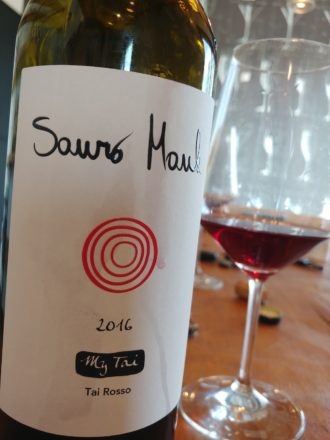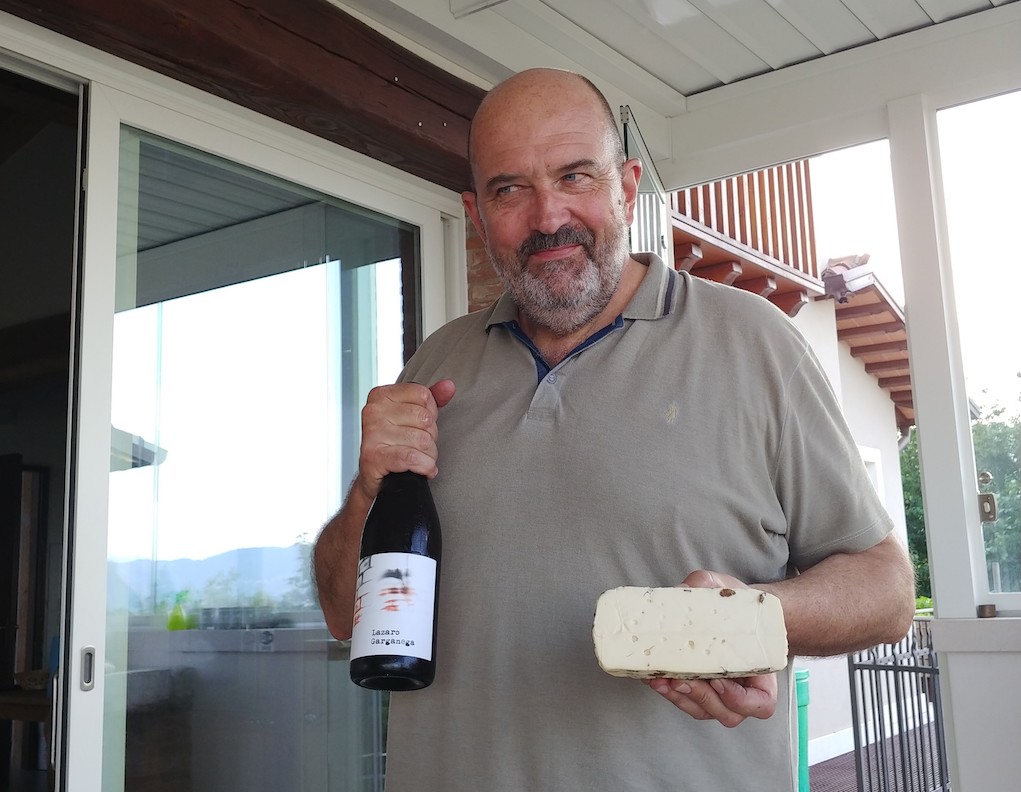It is a complicated issue, discovering our power. The idea is simple – that it is always there – as the Good Witch of the North in The Wizard of Oz tells Dorothy, “You always had the power”. But the reality is intricate as life can twist and alter what was once extraordinary on its own if we do not have the descipline and implement the consistent effort to keep our unique beauty alive.
Vin Natur
Natural wine is one of those topics that puts forth the idea of preserving the natural beauty of the grapes coming from the vineyards. But there are so many questions from wine drinkers in regards to these wines: What does natural wine mean? Who can call themselves natural winemakers? What are the parameters to be considered for natural wine? Back in June, I had a chance to meet with a living legend in the natural wine world, Angiolino Maule, and to experience a workshop that was led by Vin Natur, an organization started by Angiolino and associates that has a dream of producing wines in the most natural way possible; and so through the entire process, from the vineyard to the winery to bottling, there are guidelines for those producers who would like to work in a natural way.
Angiolino Maule
At one point, when I was with Angiolino at his winery, La Biancara di Angiolino Maule, he said that a natural winemaker knows that one does not “need anything from the outside because you can find a lot of things from the inside”. This point was especially true when it came to using natural bi-products from his wines to fix potential faults, yet he prefers to avoid these faults altogether by putting in the many hours of work it takes in his vineyards, with his sons, and obsessively watching his wines in his tanks and barrels to nip a problem in the bud, so to speak, before it gets out of hand.
Angiolino, who has been spearheading the natural movement with a handful of colleagues since the 1990s, owns some pretty spectacular vineyards in Gambellara, Veneto, and does not need to use pesticides because he has strengthened his vines to the point where they can fight off problematic issues – of course it doesn’t hurt that he and his sons are in the vineyards almost everyday at 5am breaking their backs to stop any indication of disease. That is where Vin Natur becomes important to the other 200 members who know how to make “healthy wines” but needed to know how to make “good wines”; out of the 215 wines tasted by myself and the group of experienced wine tasters from all around the world, only a few wines were considered faulted – a big leap from when this organization first started back in 2006.
Core Values
Actually, I ended up having three different visits with Angiolino Maule’s family, as I was the one with the longest commute (from NYC to Veneto) that came to the workshop and so I was there a couple days more than others. I could see the Maule’s family commitment to their “natural” way of life… and despite a few challenges being acceptable to them as some things were out of the Maule’s control, other problems that could have been prevented with hard work, and only reared its ugly head because of laziness, are not acceptable under the Maule’s way of natural living.
The last time I saw the Maule family, I was having breakfast on their porch where, during a particular time of year, that same patio is crowded with their Garganega grapes, hanging bunch by bunch on vertical nets, continually being moved around to allow each grape to evaporate its water and concentrate in the ideal way to make their mind blowing Recioto sweet wine. I realized that it is not enough to just know that we have everything we need inside… we have to be able to fight for it; in Angiolino Maule’s case with Vin Natur, the fight becomes even more vital as it will help others know that at the end of the day the struggle is worth it and that there is no place like home.

Cathrine’s Recommendations
Everyday Drinking Wine (less than $15)
2014 La Biancara di Angiolino Maule, ‘Garg’n’Go’, Pét-Nat, Veneto, Italy ($14.99): Majority Garganega with some Durella – both local grape varieties of Veneto with the Garganega being the white noble grape of the province of Vicenza where Angiolino Maule is located; the Durella grape adds acidity. This is a Pét-Nat, aka Pétillant Naturel, which is typically made by the wine being bottled prior to its first fermentation, allowing carbon dioxide to be produced by the natural sugars found in the grapes, and it was mainly practiced in the rural areas of Europe since the 16th century. In this case, Angiolino allows the first fermentation in stainless steel tank and then adds dried grapes from his Recioto wine (see last wine) and has it re-ferment again in bottle. Pét-Nat has become a big trend with younger wine drinkers in cities around the world. As in the case of most of Angiolino’s wines, this is offered at a great value, and his natural way of working is expressed in this slight fizzy, fun wine that is meant for one to “garg’n’go”. During my first visit to the Maule house I was offered a glass that was from 2014 – I could not believe it because it was still fresh with golden apples that was laced with hints of nuts and toast. It was fun yet with some delicious complexity. I would have never guessed that any Pét-Nat could age so beautifully.
Special Occasion Wine (from $15 to $50)
2017 La Biancara di Angiolino Maule, ‘I Masieri’, Veneto, Italy ($18): The Masieri wine is their entry level white that is anything but an entry level wine. It is their second selection from their vineyards that is made up of majority Garganega and a small percentage of Trebbiano – both grapes that are capable of quality when grown in ideal conditions such as in Angiolino’s case, although many other producers will grow these grapes for quantity. This wine is probably the easiest to find, as many of his wines can really only be found in Italy as well as Japan where he has a devoted market. But one can find it in New York City at Wine Therapy. Masieri has the same intense energy and bright edge that many of Angiolino’s wines have, but it does not have the same depth and complexity. This 2017 had pear skin and lemon zest with a hint of texture that finished with wet stones. It is definitely a couple notches above many other white wines in this price point.
2016 Masiero, ‘Lazaro’, Veneto, Italy ($35): 100% Garganega. This wine was made by the Masiero family with Gianfranco Masiero retired from his past life doing factory work to finally living his dream of having a farm and making wine. Gianfranco’s daughter, Giulia, is the winemaker and my goodness is this a warm family – they welcome you with open arms and their sweet nature makes you never want to leave their home/winery. I actually tasted this wine blind during our workshops with Vin Natur, as Masiero is a member, and found it exotic and wild with a mix of green mango and a savage earthiness. Lazaro is a white wine that sees skin contact and so that is why it has a deep golden color. This family is constantly experimenting, such as using tiny vessels made from marble, and it will be exciting to see how they will evolve with time. This wine can be found at Verve Wine.
2016 Sauro Maule, ‘My Tai’, Veneto, Italy (not available in the US yet): 100% Tai Rosso. Sauro Maule is not related to Angiolino but he is one of his students who studied under him and Sauro is a member of Vin Natur. Despite Sauro submitting one of the white wines, his Garganega called ‘Pri’, that ended up being one of the top wines out of the Vin Natur blind tasting workshops, I wanted to recommend a light red that I simply fell in love with… this Tai Rosso, genetically related to Grenache, has some qualities similar to its more famous sibling yet Tai Rosso has bigger berries, thicker skins and higher acidity. This ‘My Tai’ had brambly fruit with an underlying stony quality that had hints of spices and a juicy, black cherry finish. His winery ‘Il Cavallino’ is in Montebello, in the province of Vicenza as well, where his family has had a long history as cattle ranchers. His winery is quite stunning to see as it has all the latest technology and the deep calcareous soil he talks about is evident all around his estate.
2004 La Biancara di Angiolino Maule, ‘Pico’, Veneto, Italy ($26): 100% Garganega. This is the top level dry white wine from Angiolino and it is the ideal expression of the volcanic hills that surrounds his La Biancara estate. In the best vintages they will produce 3 different Crus from the high altitude, outstanding vineyards where Pico is sourced, giving them their single vineyard names: Taibane, Monte di Mezzo and Faldeo. This Pico had a beautiful copper color since it saw skin contact as well, although Angiolino is careful to not leave it on the skins too long as he does not want the technique to cover the expression of terroir. A wine that was still very vibrant and electric in its acidity with a rich body that had refined texture and lush lemon curd flavors with hints of honeysuckle and singed thyme. One of those wines I will not forget and mind boggling that one could potentially get it for so little. One can place a vintage alert at Wine.com.
Fantasy Wine (over $50)
2015 La Biancara di Angiolino Maule, Recioto di Gambellara, Veneto, Italy ($55 for 500ml): Tasted from barrel. 100% Garganega and a real specialty made in Gambellara. I do not have a long history of liking sweet wines but what I have realized over time is that ANY wine made in an extraordinary way will win me over, and hence, why this Recioto di Gambellara won me over… as I mentioned in the article above, this wine goes through the painstaking process of hanging each bunch on vertical nets on the Maule’s porch that are then constantly moved around depending on the progress of water loss. An intense smoky minerality drew me in with orange blossoms, candied ginger and a freshness that lifted the rich body caressing the palate like ribbons of silk. This wine is made in small quantities and released after 3 years, and so, if you see it in your marketplace, snatch it up as winemakers rarely make sweet wines made from dried grapes made in such a labor intensive way anymore.

























